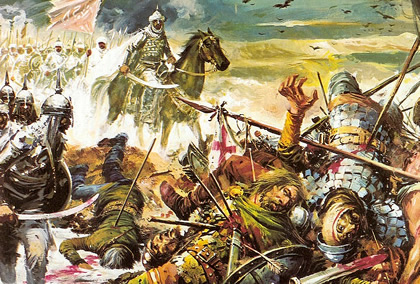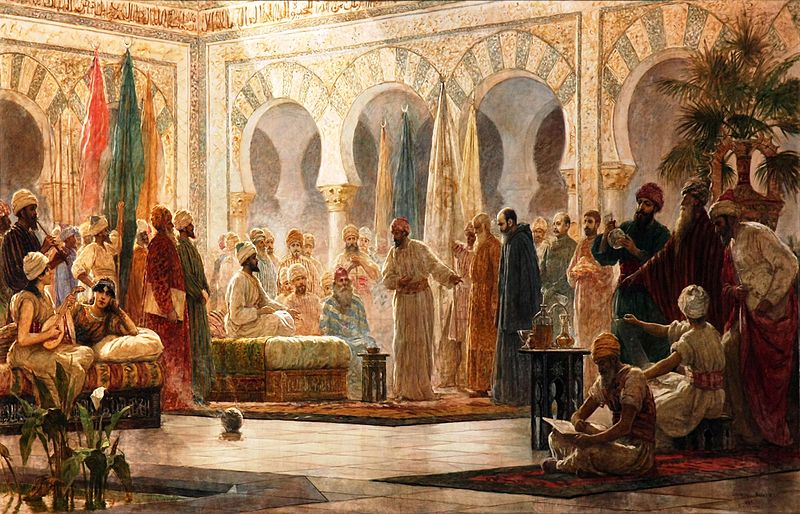 |
| Inside Alhambra, Granada, Spain |
In 711 the Muslims had conquered the southern parts of the Iberian Peninsula. By 714 following the decline of the Visigoths, the Muslims had gained a strong grip on virtually the entire Iberian Peninsula. The parts in southern Spain that were under Muslim rule were called al-Andalus.
The vast region was divided into five administrative provinces—Lusitania, and the Ebro region. The administrative system was subject to change as the Christians regained more power over parts of Muslim Spain in the following centuries.
However Muslim Spain was not restricted to the region named al-Andalus. The Muslims also controlled parts of Aragon-Catalonia and Navarre. Parts of southern France fell briefly under Muslim rule but a strong French military force under Charles Martel managed to drive them away in 756.
Although Córdoba was not the capital city of previous rulers such as the Byzantines and the Romans, it lay at the crossroads of important trade routes. Moreover the city possessed rich agricultural resources. From there the caliphs ruled parts of North Africa and the Iberian Peninsula.
The Muslims had, in fact, amassed a vast empire stretching from Spain to India and ruled diverse groups of people, who contributed to the later development of a sophisticated culture in a cosmopolitan setting found in Muslim capitals such as Córdoba. By 757 al-Andalus had been clearly established as a Muslim polity with a mainly Arab and Berber population, but also with many converts.
Within Muslim Spain, the Umayyad dynasty ruled over Arabs from various locations as well as Berbers, Jews, Christians. The lingua franca used by diverse groups of people within al-Andalus was Arabic.
Umayyad Dynasty
In 750 after a series of rival wars between various Muslim factions, the Umayyad Abd al-Rahman Mu’awiya, also known as Abd al-Rahman I, refused to acknowledge the Abbasid Sunni Caliphate based in Baghdad.
By this time the Abbasid dynasty was considered corrupt and weak. This led Abd al-Rahman to set up his own dynasty of emirs of Córdoba, first by ousting the previous ruler, Yusuf al-Fihri.
Abd al-Rahman proclaimed himself the first emir of Córdoba in the mosque of Córdoba on May 14, 756. The powerful Fatimid dynasty, based in Egypt, opposed the installation of the Umayyad Caliphate on Córdoba. The Fatimid dynasty had a strong hold over North Africa.
 |
| inside Cordoba (former) Mosque |
Abd al-Rahman thus enlisted the help of the Zanata Berber tribe enemies of the Sinhaja tribe, allies of the Fatimids. Pro-Umayyad rebellions against the Fatimids were quashed and Abd al-Rahman was unable to advance into North Africa, as he was preoccupied with skirmishes with the Christians.
He ruled independently of the Abbasid Caliphate for 33 years, consolidating sufficient support for Umayyad authority to ensure the longevity of his dynasty. Abd al-Rahman succeeded in fending off Yusuf al-Fihri’s allies as well as the supporters of the Abbasid Caliphate within al-Andalus.
Later on the emirate became known as the Umayyad Caliphate, which was in fact modeled upon the older Abbasid Caliphate. The Umayyads, who were members of the prophet Muhammad’s tribe Qureish, claimed to be descendants from the prophet Muhammad.
Prior to conquering parts of the Iberian Peninsula the Umayyads had already ruled a huge part of the Muslim world including the important city of Samarkand at the eastern edge of their kingdom. Their conquests stretched to al-Andalus in the west with its capital in Córdoba.
By the time of Abd al-Rahman I’s death in 852, al-Andalus was already a major diplomatic power in the Mediterranean with emirates established over North Africa. Links had also been established with the Byzantine emperor, another major player in Mediterranean politics.
Visigoth Resistance
 |
| Visigoth Resistance |
Initially the Muslim power that was responsible for the great wave of Muslim expansion was based in their distant capital city of Damascus. In Muslim Spain, however, Córdoba was made the capital, where the Muslim invaders settled down as property owners soon after their victory over the Visigoths.
One way land was acquired in Córdoba was through marriage with important members of the Visigothic aristocracy. This had the added advantage of staving off potential opposition from the Visigoths, who had been the ruling class in Córdoba before their defeat at the hands of the Muslims.
Despite the Visigoths’ apparent truce with the Muslims within Spain, members of the Visigothic aristocracy who had fled up north of the Iberian Peninsula continued to resist Muslim rule in the south.
This was an impetus for the Muslims to invade the northern mountainous region of the peninsula, as well as France. The Muslim invaders were especially looking to gain resources in France rather than the inaccessible regions in northern Spain. This expansion came to an end when the three major military expeditions to France during the eighth century ended in disastrous defeats.
Umayyad caliphs in al-Andalus had a policy of tolerance toward the non-Muslims under their rule. Non-Muslim residents had to pay a poll tax (jizya) and a land tax. Thus the greatest source of tax revenue, was the non-Muslim inhabitants of al-Andalus. This contributed to the policy of tolerance of the Christian and Jewish population. Conversion to Islam escalated under the reign of the Umayyad Caliphate.
During the ninth century mass conversions took place. The benefits of conversion included employment opportunities in government. Not only did Muslims pay significantly less tax than non-Muslims, they could also gain better positions in the bureaucracy.
In fact the unifying bonds between the various groups of people were culture and literature, rather than religion, which created a harmonious setting. There was a large Christian group within Muslim Spain known as the Seville.
They adopted a Muslim lifestyle, in terms of fashion, architecture, and literature, without converting to Islam. These Mozarabs suffered religious persecution in 1139 by fellow Christians after the raids of King Afonso I (Henriques) of Portugal on Seville, as they were not considered true Christians.
Umayyad Dynasty of Cordoba
 |
| Umayyad Dynasty of Cordoba |
The caliph of Córdoba, formerly known as the emir of Córdoba, ruled Spain for slightly more than a century, from the year 929 to 1031, beginning with the reign of the most powerful Muslim ruler, Abd ar-Rahman III, who claimed the caliphate in 929.
The caliph was especially skilled at projecting his image as a powerful Arab leader. Abd ar-Rahman III made sure he was visible to his people in the many ceremonies and processions organized for him. The caliph presented himself as an effective leader of his own military troops. In his image campaign, newsletters and poems were glowingly written of his military prowess and piety.
During this period, in addition to having a reputation as an illustrious commercial center, al-Andalus also became an eminent center of knowledge and learning. Al-Andalus was a great civilization, compared with the rest of Europe at that time. Many Islamic works of art were produced during this kala of Muslim rule.
Umayyad caliph Abd Al-Rahman III had a keen interest in the arts, as well as the religious and secular sciences. He amassed many books from other intellectual centers such as Baghdad, which were then stored in the library. Scholars were also hired to supplement further the amount of written knowledge imported.
Drawn to the bastion of knowledge and culture, many philosophers and scientists began to migrate to al-Andalus, making it a renowned center of learning. Intellectual life in Córdoba peaked during the reign of Al-Hakam II, who was in power from 961 to 967.
He was responsible for establishing a massive library filled with hundreds of thousands of volumes, a useful repository of knowledge in the Mediterranean world. During this period several intellectuals achieved prominence in Muslim Spain.
Spanish Muslim intellectuals excelled in the fields of mathematics, medicine, and astronomy. The most famous example is Ibn Rushd, otherwise called Averroës, who was a philosopher, theologian, physician, and sometime royal consultant, born and educated in Córdoba.
Christian Reconquest
Simultaneously the territories owned by the caliph of Córdoba decreased just as aspects of commerce and culture thrived. Internal dissension among different Arab factions weakened the Umayyad power base in Córdoba as they disintegrated into warring divisions.
The lack of Muslim unity proved crucial to Christian success. During the reign of Hisham II, the Umayyad Caliphate disintegrated into party-kingdoms in 1009. He was executed in 1013, only to be succeeded by another weak ruler, Hisham III, the last caliph of Córdoba.
Hisham III was exiled to Lerida. Nominal rule continued under the short-lived Hasanid dynasty until 1054. The further remaining territories dwindled into mere Muslim principalities, better known as independent taifas, ruled by mainly Berber rulers, though there were also non-Berber rulers.
With their defenses weakened because of lack of unity, these taifas often had to hire mercenaries from North Africa or Christian mercenaries to protect their principalities, which were constantly at war with each other. This chaotic situation in the Muslim states was conducive to Christian reconquest.
Christians in the northern parts of the Iberian Peninsula had already begun to consolidate their military and political power as early as the eighth century, and into the latter half of the ninth century.
Under the reign of Alfonso II (791–842), the Christians in the northern region had stabilized themselves. He was able to install Visigothic institutions in his kingdom with his capital in Oviedo.
The Christians viewed the reconquest of southern Spain (al-Andalus) as justified, since they were reclaiming what rightfully belonged to the Visigoths. Further impetus was provided by the discovery of the tomb of St. James the apostle, a patron saint around whom the Christians could rally.
From the eighth to the 10th century the Christian north had possessed an inferior economic system and cultural milieu compared to al-Andalus in the south. However they were already clearly formed political entities with military forces that were able to stave off attacks from their enemies from the south. This enabled them to reconquer Muslim Spain upon its disintegration during the 10th and 11th centuries.
In 1056 the Almoravid Empire took over as the rulers of Muslim Spain. They were replaced by the dynasty of Almohads in 1130. The decline of the Almohads in 1269 enabled the Christians to conquer parts of Muslim Spain with more ease.
The important cities of Córdoba and Seville had already fallen into Christian hands in 1236 and 1248, respectively, leaving only Granada as the last Muslim stronghold. In 1469 through the union of Ferdinand of Aragon and Isabella of Castille, much of Spain was united. By 1492 a stronger Christian Spain finally took over Granada.
EmoticonEmoticon